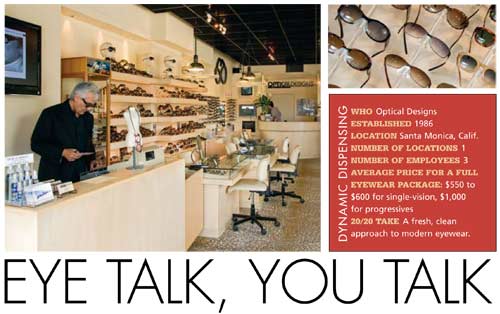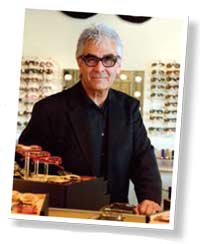
By Lauren Taylor
Photographs by MARCEL ESKENAZY
When Rick Hogan opened his optical retail shop, Optical Designs, in 1986, “Top Gun” was causing a frenzy for aviator sunglasses and gas was $.93 a gallon. Prices have definitely changed since then, but fashion trends have come full circle back to aviator shapes. All the while Hogan remained true to his original mantra: Good customer service never goes out of style.
Hogan became interested in eyewear when he had to wear it as a child. After being told that optometry school was too expensive and too intense, he chose instead to be an optician, going to school and working two jobs—waiting tables to pay for school and volunteering in an optical shop to gain experience in the field. “For the first year I worked in an optical store for free because I wanted to learn the retail aspect of the field,” he says. “I realized eyewear was an important part of the optical field. Eyeglasses were just becoming a fashion accessory, more than just a clinical device.”
After graduation, Hogan worked at the same store—this time for pay—until he decided to branch out on his own. After looking at various mall locations, Hogan settled on a small space on Montana Avenue near an affluent residential area in Santa Monica, Calif. “I got a good feeling about this street,” he says. “It’s a very neighborhood-oriented area where the people all know each other and talk to each other. Most of the stores are privately owned and operated.”
The first optical shop on the street, Hogan’s store is in a high foot traffic area near restaurants and a small theater that shows art films. As the area grew, other shops opened, and now Optical Designs is one of seven optical operations on the street, one of six with retail space.
“I don’t worry about the competition,” says Hogan. “At the beginning it concerned me, but I took the attitude that if I do my work properly and listen to customers and serve them the best I can, I should be okay. And so far I have been.”
Hogan originally reacted to the competition by increasing his inventory and ended up with too much backstock. He now has almost 1,100 frames on display in the 650-square-foot retail area.
“If you listen to your customers, they will tell you what they want,” says Hogan, who now chooses his inventory based on customer input. “We designed the store to encourage people to talk to us. The more we communicate, the better chance they will take something positive from the store, even if they don’t buy anything. They’ll remember how we presented ourselves and the product.”
And presentation is key, according to Hogan, whose preeminent concern is the initial impression of each customer who walks through the door. “Customers always want to feel like they’re dealing with a successful operation,” he says. “If the shop looks shoddy or the inventory looks depleted, people will say, ‘I don’t know, it looks like they are going through a hard time; maybe I need to be concerned with how they might take care of me.’”
Hogan schedules a painting crew to come each July to touch up the walls and worn spots on the counters where there is basic wear and tear on the store. He also makes sure to have the carpets cleaned once a year. “It’s worth the little bit of money to keep the store fresh,” he says.
Most of the store’s inventory is kept in glass cases, with small displays and sculpture blocks scattered around the store. Artistic arrangements are created with one or two frames to show off the style and give the customer an idea of what the line is all about, while the rest of the collection is behind glass. Front window displays are changed about once a month in order to showcase new product. Hogan also has two LCD screen TVs, a 42-inch one behind the front desk and a 20-inch one towards the back of the store, which plays DVDs of production footage, catalog and magazine clippings to show off product. “People will pay attention to them and ask, ‘What company is that?’” says Hogan. “It gives them something to look at if we can’t help them right away.” He also has an “actor’s portfolio” of articles and pictures of celebrities wearing eyewear for the customers to flip through. Although with his location, many of his customers are celebrities themselves.
In order to keep the store looking fresh and open, inventory control is important. Hogan listens not only to customers, but also to eyewear representatives in order to keep his stock new and unique. “I really take a tight look at the inventory. If I need something, I look to see if I can use another product or look deeper into a product line I already have,” he says. “I like carrying small lines where I can pick up the phone and talk to someone closer to the product than a customer service representative. Most times I can call the president or the owner of the company to talk, since that’s who does the selling anyway.”
 The store carries lines like Salt, Oliver Peoples, Proenza Schouler, Theory, Barton Perreira and Sutro. “Having a good product mix is important. You always have to challenge the customer’s curiosity.” Hogan keeps a combination of both classic and artistic styles to help customers think outside of the box. Recently, customers have been shying away from large logos on their eyewear, looking more for subtle quality from brands.
The store carries lines like Salt, Oliver Peoples, Proenza Schouler, Theory, Barton Perreira and Sutro. “Having a good product mix is important. You always have to challenge the customer’s curiosity.” Hogan keeps a combination of both classic and artistic styles to help customers think outside of the box. Recently, customers have been shying away from large logos on their eyewear, looking more for subtle quality from brands.
“When the economy is perceived to be strong, people like to show they are recipients of that economy; that’s when brand names start appearing on the outside of frames,” says Hogan. “But when the economy is not so good, people draw back. It’s not the cost, they just want to show off less.” The store stock now features quality fames with subtle branding marks.
When his store doesn’t have what the customer is looking for, Hogan won’t hesitate to send them to another optical shop nearby. “People don’t expect me to do that, but I like to keep the customers on this street,” he says. This way, he also builds a good reputation among both his customers and his competition, something that has become invaluable in the past 22 years.
“It’s surprising how word gets around,” says Hogan. “Our reputation does precede us a little bit.” By taking care of customers, Hogan gains word-of-mouth advertising that no newspaper ad could ever accomplish.
If a customer comes into Optical Designs and buys a pair of eyewear they later decide isn’t right for them, Hogan will spend the extra money to make them another pair of glasses rather than let them leave unhappy. “I’d rather lose money and have the customer walk out happy,” he says. This kind of customer first attitude has kept Hogan successful for almost a quarter of a decade.
“I love what I do and I feel privileged to have the opportunity to do it,” he says. “Every day is an adventure. I love finding the right frame for someone, because you can actually change a person’s perspective of themselves by putting glasses on them. It’s fun trying to find that aspect of their character that they want to show off. And after 22 years, I still enjoy doing that.”











